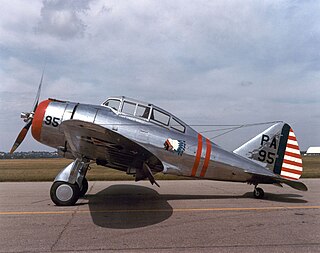
The Martin B-10 was the first all-metal monoplane bomber to be regularly used by the United States Army Air Corps, entering service in June 1934. It was also the first mass-produced bomber whose performance was superior to that of the Army's pursuit aircraft of the time.

The Dewoitine D.500 was an all-metal, open-cockpit, fixed-undercarriage monoplane fighter aircraft designed and produced by French aircraft manufacturer Dewoitine.

The Curtiss P-36 Hawk, also known as the Curtiss Hawk Model 75, is an American-designed and built fighter aircraft of the 1930s and 40s. A contemporary of the Hawker Hurricane and Messerschmitt Bf 109, it was one of the first of a new generation of combat aircraft—a sleek monoplane design with a retractable undercarriage making extensive use of metal in its construction.

The Mitsubishi A5M, formal Japanese Navy designation Mitsubishi Navy Type 96 Carrier-based Fighter (九六式艦上戦闘機), experimental Navy designation Mitsubishi Navy Experimental 9-Shi Carrier Fighter, company designation Mitsubishi Ka-14, was a WWII-era Japanese carrier-based fighter aircraft. The Type number is from the last two digits of the Japanese imperial year 2596 (1936) when it entered service with the Imperial Navy.

The Curtiss-Wright XF-87 Blackhawk was a prototype American all-weather jet fighter-interceptor, and the company's last aircraft project. Designed as a replacement for the World War II–era propeller-driven P-61 Black Widow night/interceptor aircraft, the XF-87 lost in government procurement competition to the Northrop F-89 Scorpion. The loss of the contract was fatal to the company; the Curtiss-Wright Corporation closed down its aviation division, selling its assets to North American Aviation.

The Nakajima Ki-43 Hayabusa, formal Japanese designation Army Type 1 Fighter is a single-engine land-based tactical fighter used by the Imperial Japanese Army Air Service in World War II.

The Seversky P-35 is an American fighter aircraft built by the Seversky Aircraft Company in the late 1930s. A contemporary of the Hawker Hurricane and Messerschmitt Bf 109, the P-35 was the first single-seat fighter in United States Army Air Corps to feature all-metal construction, retractable landing gear, and an enclosed cockpit.

The Curtiss-Wright XP-55 Ascender is a 1940s United States prototype fighter aircraft built by Curtiss-Wright. Along with the Vultee XP-54 and Northrop XP-56, it resulted from United States Army Air Corps proposal R-40C issued on 27 November 1939 for aircraft with improved performance, armament, and pilot visibility over existing fighters; it specifically allowed for unconventional aircraft designs. An unusual design for its time, it had a canardconfiguration towards the nose, a rear-mounted engine, swept wings, and two vertical tails. Because of its pusher design, it was satirically referred to as the "Ass-ender". Like the XP-54, the Ascender was designed for the 1,800hp Pratt & Whitney X-1800 24-Cylinder H-engine, but was redesigned after that engine project was canceled. It was also the first Curtiss fighter aircraft to use tricycle landing gear.

The Vultee P-66 Vanguard was a United States Army Air Forces fighter aircraft. It was initially ordered by Sweden, but by the time the aircraft were ready for delivery in 1941, the United States would not allow them to be exported, designating them as P-66s and retaining them for defensive and training purposes. Eventually, a large number were sent to China where they were pressed into service as combat aircraft with mixed results.

The Mitsubishi J2M Raiden is a single-engined land-based fighter aircraft used by the Imperial Japanese Navy Air Service in World War II. The Allied reporting name was "Jack".

The Mitsubishi Ki-46 was a twin-engine reconnaissance aircraft used by the Imperial Japanese Army in World War II. Its Army Shiki designation was Type 100 Command Reconnaissance Aircraft (一〇〇式司令部偵察機); the Allied brevity code name was "Dinah".

The Kawasaki Ki-45 Toryu was a two-seat, twin-engine heavy fighter used by the Imperial Japanese Army in World War II. The army gave it the designation "Type 2 Two-Seat Fighter"; the Allied reporting name was "Nick". Originally serving as a long-range escort-fighter, the design — as with most heavy fighters of the period — fell prey to smaller, lighter, more agile single-engine fighters. As such, the Ki-45 instead served as a day and nighttime interceptor and strike fighter.

The Central Aircraft Manufacturing Company, also known as the Loiwing Factory (雷允飛機製造廠) after they moved to Yunnan, was a Chinese aircraft manufacturer established by American entrepreneur William D. Pawley in the 1930s.

The Curtiss P-6 Hawk is an American single-engine biplane fighter introduced into service in the late 1920s with the United States Army Air Corps and operated until the late 1930s prior to the outbreak of World War II.

The Curtiss F11C Goshawk is an American naval biplane fighter aircraft that saw limited success. It was part of a long line of Curtiss Hawk airplanes built by the Curtiss Aeroplane and Motor Company for the American military.

The Royal Netherlands East Indies Army Air Force was the air arm of the Royal Netherlands East Indies Army in the Dutch East Indies from 1939 until 1950. It was an entirely separate organisation from the Royal Netherlands Air Force.

The Curtiss-Wright CW-22 was a 1940s American general-purpose advanced training monoplane aircraft built by the Curtiss-Wright Corporation. It was operated by the United States Navy as a scout trainer with the designation SNC-1 Falcon.

The Curtiss Fledgling, known internally to Curtiss as the Model 48 and Model 51 was a trainer aircraft developed for the United States Navy in the late 1920s and known in that service as the N2C.

The Curtiss-Wright CW-19 was a civil utility aircraft designed in the United States in the mid-1930s and built in small quantities in a number of variants including the CW-23 military trainer prototype.

The Vought V-141 was a prototype American single-seat fighter aircraft of the 1930s. It was a development of the unsuccessful Northrop 3-A design, but was itself a failure, being rejected by the United States Army Air Corps. The sole prototype was sold to the Japanese Army in 1937, but no production followed, with the type proving to be inferior to existing Japanese fighters.






















